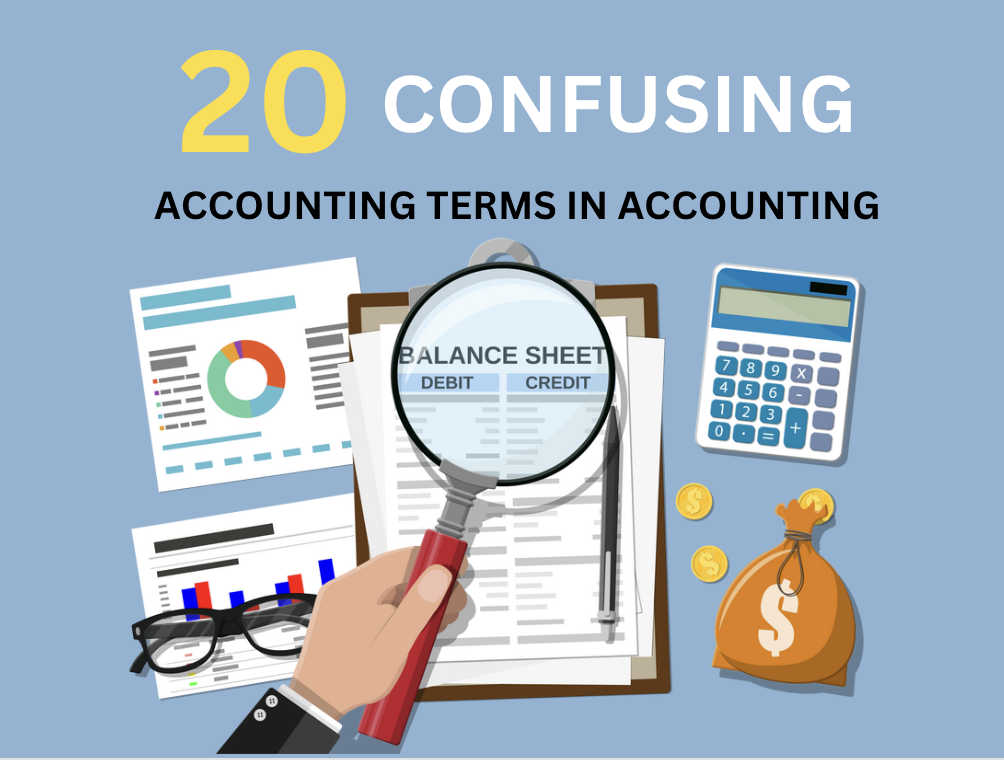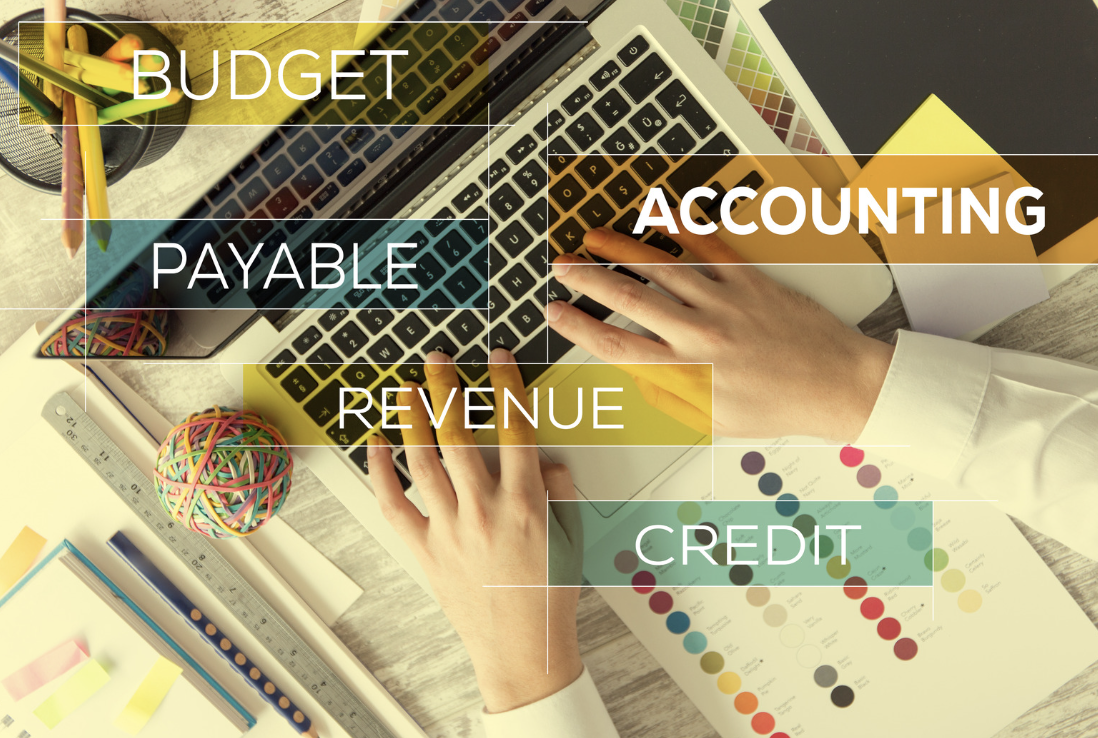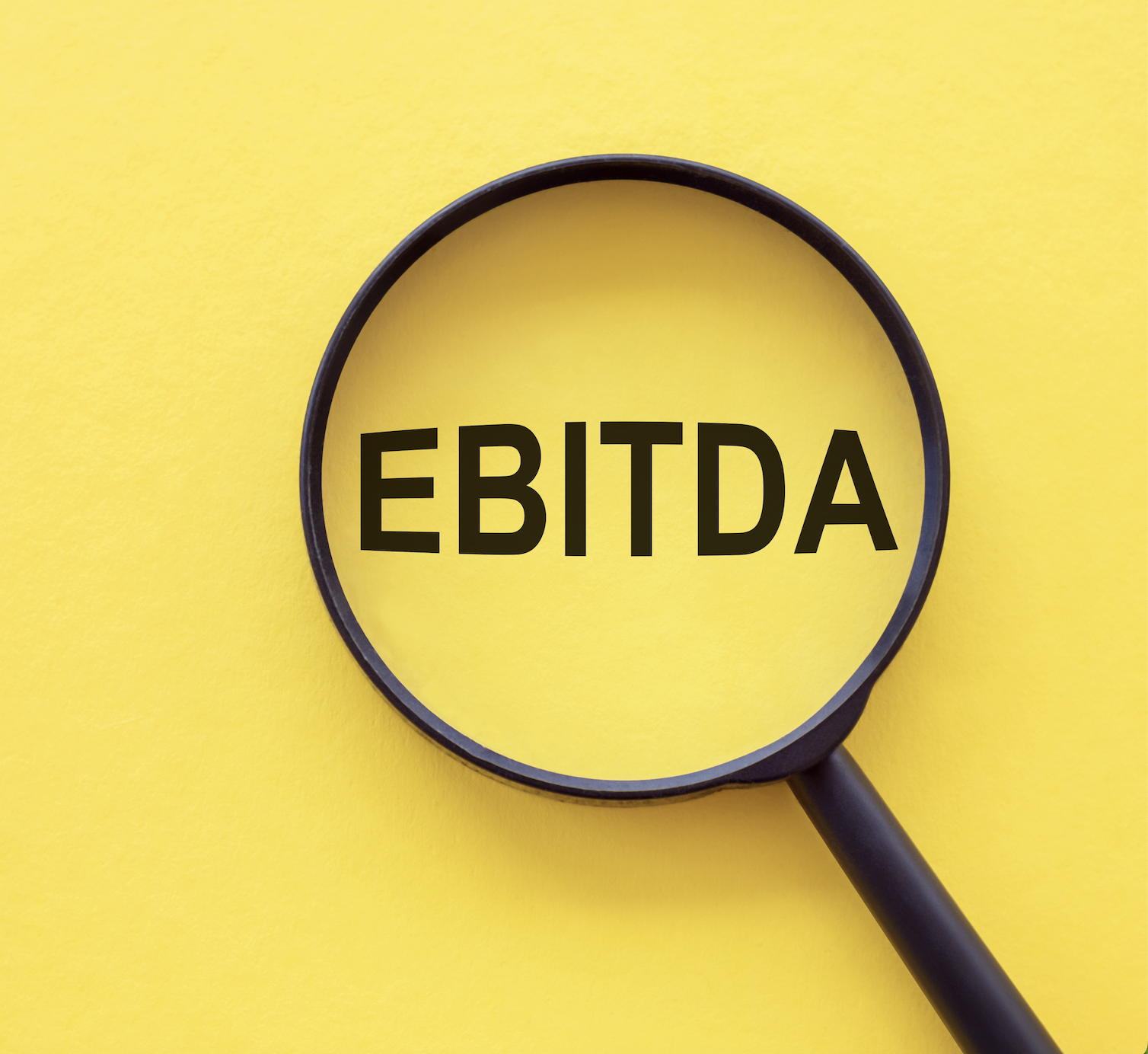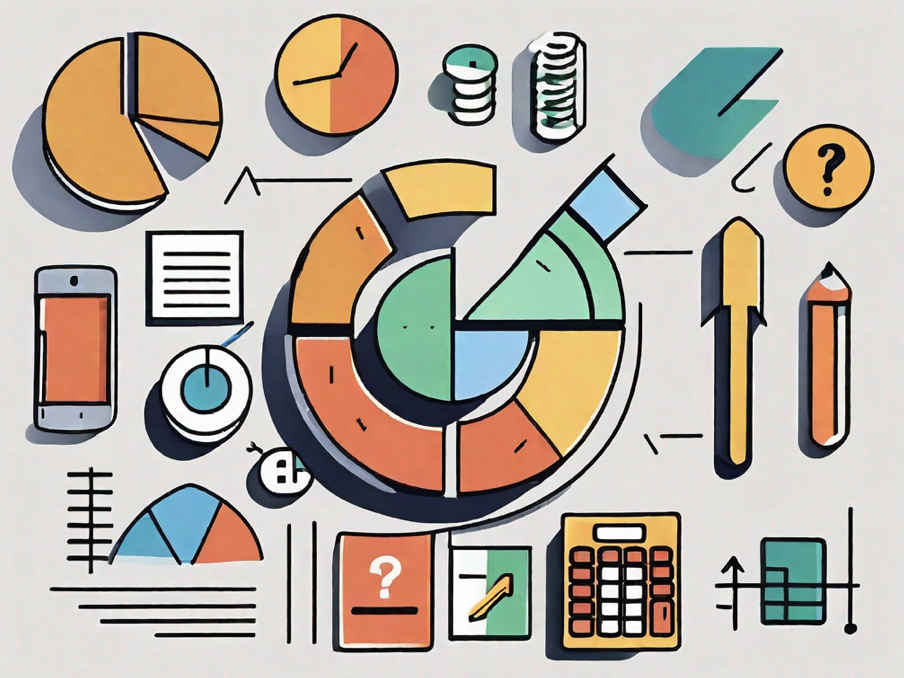20 CONFUSING ACCOUNTING TERMS IN ACCOUNTING
Demystifying Accounting Terms and Definitions: Clearing the Confusion Around 20 Complex Accounting Concepts! A guide to understanding the world of accounting.
20 CONFUSING ACCOUNTING TERMS IN ACCOUNTING
Demystifying Accounting Terms and Definitions: Clearing the Confusion Around 20 Complex Accounting Concepts! A guide to understanding the world of accounting.

In the world of accounting, there are numerous terms that can often leave even the most experienced accountants scratching their heads. These terms can be confusing due to their similarities or subtle differences in meaning. Accounting can be a complex field, filled with numerous terms and concepts that can leave even seasoned professionals scratching their heads. In this article, we’ll explore twenty confusing accounting terms and break them down into simpler explanations. Whether you’re a student just starting your accounting journey or a business owner looking to gain a better understanding of financial statements (Check how to read Financial Statements), this guide will help demystify these concepts and provide clarityIn this article, we will explore 20 commonly misunderstood accounting terms and shed light on their distinctions. So, let’s dive right in and unravel the mysteries behind these complex concepts!
Accounting Terms That Leave Even Accountants Stumped
Additionally, there are several accounting terms that continue to perplex even seasoned accountants. These terms may have intricate definitions or complex applications that can make them difficult to grasp for anyone in the field. Accountants must learn difficult accounting terms and ask for help when needed to report finances accurately and communicate effectively.
Understanding the Language of Accounting: Commonly Misused Terms
When studying accounting, it’s crucial to clarify commonly misused terms to avoid confusion and misunderstandings. Terms like “revenue” and “income” or “profit” and “cash flow” are often mistakenly used interchangeably, but they have distinct meanings in accounting. Taking the time to thoroughly understand and use these terms correctly can significantly enhance communication in the accounting realm.
1. Accruals vs Cash Basis Accounting
Accruals and cash basis accounting are two different methods used to determine when revenue and expenses should be recorded in financial statements. Accrual accounting recognizes transactions when they occur, irrespective of the time when cash is received or paid. On the other hand, cash basis accounting only recognizes revenue and expenses when cash is exchanged. Although both have their advantages and disadvantages, understanding the differences between these two methods is crucial for accurate financial reporting.
Accrual accounting is considered the more accurate and widely used method in financial reporting. This method takes into account all economic events, regardless of whether cash has been exchanged. By recognizing revenue and expenses when they occur, accrual accounting provides a more comprehensive view of a company’s financial performance. It allows businesses to match revenues with the expenses incurred to generate those revenues, providing a more accurate representation of profitability.
For example, let’s consider a company that sells products on credit. Under accrual accounting, the revenue from the sale would be recognized when the sale is made, even if the customer has not yet paid. This allows the company to reflect the true economic impact of the sale, rather than waiting for the cash to be received. Similarly, expenses are recognized when they are incurred, regardless of when the cash is paid. This ensures that the financial statements reflect the true costs associated with generating revenue. On the other hand, cash basis accounting is a simpler method that recognizes revenue and expenses only when cash is received or paid. This method is often used by small businesses or individuals who do not have complex financial transactions. Cash basis accounting provides a straightforward view of a company’s cash flow, as it focuses solely on the movement of cash in and out of the business.
However, cash basis accounting has its limitations. It may not accurately reflect a company’s financial performance, as revenue and expenses may be recognized in different periods than when they actually occurred. This can result in misleading financial statements, especially if there are significant time lags between when a transaction occurs and when cash is exchanged.
Furthermore, cash basis accounting does not provide a complete picture of a company’s financial position. It does not take into account any outstanding liabilities or receivables, as they are not reflected until cash is exchanged. This can make it difficult for businesses to assess their current financial health and make informed decisions based on accurate financial information. While both accrual and cash basis accounting have their advantages and disadvantages, accrual accounting is generally considered the more accurate and reliable method for financial reporting. It provides a comprehensive view of a company’s financial performance and allows for better decision-making based on accurate and timely information. Cash basis accounting is good for small businesses or individuals with simple finances because it shows cash flow clearly. Ultimately, the choice between the two methods depends on the specific needs and circumstances of the business.
2. Depreciation vs Amortization
Depreciation and amortization are terms often used interchangeably, although they have distinct meanings in the accounting world. Depreciation refers to the systematic allocation of the cost of tangible assets over their useful lives, whereas amortization is the same concept applied to intangible assets. While both processes aim to reflect the wear and tear or the consumption of an asset’s value over time, different assets fall under each category, making it essential to differentiate between the two.
Let’s delve deeper into the world of depreciation. When it comes to tangible assets, such as buildings, machinery, or vehicles, depreciation is used to allocate the cost of these assets over their estimated useful lives. This process recognizes that these assets gradually lose value due to factors like wear and tear, obsolescence, or technological advancements. By spreading the cost of these assets over their useful lives, businesses can accurately reflect their true value on their financial statements.
Now, let’s shift our focus to amortization. Unlike depreciation, which deals with tangible assets, amortization deals with intangible assets. Intangible assets are non-physical assets that provide value to a business, such as patents, copyrights, trademarks, or goodwill. Just like tangible assets, intangible assets also lose value over time. Amortization allows businesses to allocate the cost of these assets over their estimated useful lives, reflecting the gradual consumption of their value.
It’s important to note that the useful life of an asset can vary significantly depending on the nature of the asset. A building can last for many years, but a computer may only last for a few years because technology changes quickly. The depreciation or amortization expense incurred each year will be based on the estimated useful life of the asset and the chosen depreciation or amortization method.
In addition to reflecting the wear and tear or the consumption of an asset’s value, depreciation and amortization also have important tax implications. Both depreciation and amortization expenses can be deducted from a business’s taxable income, reducing the amount of tax owed. This tax benefit helps businesses recover some of the costs associated with acquiring and maintaining assets over time.
Furthermore, depreciation and amortization play a crucial role in financial reporting. By accurately allocating the cost of assets over their useful lives, businesses can provide a more accurate representation of their financial position and performance. This info is important for investors, creditors, and others to make informed decisions about the business’s finances. While depreciation and amortization are often used interchangeably, they have distinct meanings in the accounting world. Depreciation applies to tangible assets, while amortization applies to intangible assets. Both processes allow businesses to allocate the cost of assets over their useful lives, reflecting the wear and tear or the consumption of an asset’s value over time. By understanding the differences between depreciation and amortization, businesses
3. Gross Profit vs Gross Profit Margin
When analyzing a company’s financial performance, it is crucial to understand the difference between gross profit and gross profit margin. Gross profit represents the revenue left after deducting the direct costs of goods sold. On the other hand, the gross profit margin is a percentage that represents how much profit a company earns from its revenue. Understanding the distinction between these two metrics is vital for evaluating a company’s profitability and efficiency in managing its production costs.
4. Fair Value vs Historical Cost
Fair value and historical cost are two valuation methods used for assets and liabilities. Historical cost refers to the original cost at which an asset is recorded when first acquired, whereas fair value represents the estimated price it would fetch in the current market. Historical cost is simple but not as accurate as fair value, which shows the current worth of an asset or liability. Recognizing the differences between these two methods is important for proper financial valuation and decision-making.

5. Allowance for Doubtful Accounts vs Bad Debt Expenses
Allowance for doubtful accounts and bad debt expense are both related to uncollectible receivables, but they have different roles. The allowance for doubtful accounts is a contra-asset account that estimates the potential loss due to customers’ non-payment. Bad debt expense, on the other hand, represents the actual amount recognized as a loss in the financial statements. While the two are interconnected, understanding their individual purposes is vital for accurately reporting a company’s accounts receivable and evaluating its credit risk.

6. Goodwill vs Intangible Assets
Goodwill and intangible assets are frequently confused, as both represent non-tangible assets. Goodwill refers to the value of a company’s reputation, customer base, and intellectual property, arising from acquisitions. On the contrary, intangible assets encompass a broad range of non-physical assets, such as patents, trademarks, copyrights, and software. Though related, distinguishing between goodwill and intangible assets is crucial for proper financial reporting and assessing a company’s value.
7. Fixed Assets vs Current Assets
Fixed assets and current assets are two essential categories when it comes to accounting. Fixed assets refer to long-term assets that a company holds for more extended periods, such as buildings, machinery, or vehicles. These assets play a vital role in the company’s operations and are not intended for immediate sale. They are typically used to generate revenue over an extended period. For example, a manufacturing company may have a factory building, production equipment, and delivery vehicles as fixed assets.
On the other hand, current assets are short-term assets that are expected to be converted into cash within a year. These assets are more liquid and readily available to meet the company’s short-term obligations. Examples of current assets include cash, accounts receivable, inventory, and short-term investments. Cash represents the most liquid asset, readily accessible to cover day-to-day expenses and unforeseen emergencies. Accounts receivable, on the other hand, represents the money owed to the company by its customers for goods or services provided on credit. Inventory consists of goods held for sale or raw materials used in the production process.
Understanding the distinction between these two types of assets is crucial for financial reporting and assessing a company’s liquidity. Fixed assets provide a long-term perspective on a company’s investment in tangible resources, while current assets reflect the company’s ability to meet its short-term obligations and fund its day-to-day operations. By analyzing the composition and value of fixed and current assets, stakeholders can gain insights into a company’s financial health, its ability to generate cash flows, and its overall operational efficiency.
Moreover, fixed assets and current assets have different accounting treatments. Fixed assets are recorded on the balance sheet at historical cost and are subject to depreciation or amortization over their useful lives. Depreciation is the systematic allocation of the asset’s cost over time, reflecting its wear and tear or obsolescence. On the other hand, current assets are recorded at their current market value or the lower of cost and net realizable value. This treatment ensures that current assets are not overstated on the balance sheet and accurately reflect their true economic value.
The classification of assets as fixed or current can vary based on accounting standards or industry. For example, some industries may have unique long-term assets specific to their operations, such as oil rigs for oil and gas companies or aircraft for airlines. These specialized assets would be classified as fixed assets within their respective industries. Fixed assets and current assets are crucial components of a company’s balance sheet. Fixed assets represent long-term investments in tangible resources, while current assets reflect a company’s short-term liquidity. Understanding the distinction between these two types of assets is essential for financial reporting, assessing a company’s financial health, and making informed investment decisions.
Capital Expenditures vs Revenue Expenditures

8. Capital Expenditures vs Revenue Expenditures
When it comes to accounting for expenses, differentiating between capital expenditures and revenue expenditures is essential. Capital expenditures refer to the investments made in long-term assets, such as property, plant, and equipment, with benefits expected to extend beyond the current accounting period. Revenue expenditures, on the other hand, are the day-to-day expenses necessary for a company’s operations. Recognizing the distinction between these two types of expenditures is vital for accurate financial reporting and understanding a company’s spending patterns.

When it comes to accounting for expenses, differentiating between capital expenditures and revenue expenditures is essential. Capital expenditures refer to the investments made in long-term assets, such as property, plant, and equipment, with benefits expected to extend beyond the current accounting period. Revenue expenditures, on the other hand, are the day-to-day expenses necessary for a company’s operations.
9. Fair Value vs Carrying Value
Fair value and carrying value are two terms often used to describe the worth of an asset or liability, but they represent different measures. Fair value refers to the price an asset or liability would sell for in an open market while carrying value represents its value as recorded on the balance sheet after considering any depreciation, amortization, or impairment. Understanding the differences between fair value and carrying value is crucial for accurate financial reporting and evaluating a company’s financial health.
10. Accumulated Depreciation vs Depreciation Expense
Accumulated depreciation and depreciation expense are fundamental concepts in accounting that play a crucial role in accurately reporting the financial health of a business. Understanding the difference between these terms is essential for effectively managing assets and evaluating the overall performance of an organization. Accumulated depreciation is a contra-asset account that tracks the cumulative depreciation charged against an asset since its acquisition. When a company purchases an asset, such as a piece of machinery or a vehicle, it is expected to decrease in value over time due to wear and tear, obsolescence, or other factors. Accumulated depreciation allows businesses to account for this decrease in value and reflect it on their financial statements.
Depreciation expense is the yearly cost on the income statement to show the decrease in value of an asset over time. It represents the portion of the asset’s cost that is allocated as an expense in a specific period, typically over the asset’s useful life. By spreading the cost of the asset over its useful life, depreciation expense helps to match the cost of the asset with the revenue it generates.
It is important to note that accumulated depreciation and depreciation expense are closely related but serve different purposes. Accumulated depreciation is a record of how much an asset has decreased in value since it was bought. It is deducted from the asset’s historical cost to determine its net book value, which represents the asset’s value on the balance sheet.
Depreciation expense, on the other hand, is an income statement account that reflects the portion of the asset’s cost that is allocated as an expense in a particular accounting period. It is included in the calculation of net income and ultimately impacts the profitability of the business.
Accurate and transparent reporting of accumulated depreciation and depreciation expense is crucial for financial statement users, such as investors, lenders, and stakeholders. These figures provide insights into the overall value of a company’s assets, their useful lives, and the impact of depreciation on the organization’s financial performance.
Furthermore, understanding the difference between accumulated depreciation and depreciation expense can help businesses make informed decisions about asset management. By tracking accumulated depreciation, companies can assess the remaining value of their assets and plan for future replacements or upgrades. Depreciation expense, on the other hand, allows businesses to estimate the cost of using an asset during a specific period and incorporate it into their budgeting and forecasting processes.
11. Contingent Liabilities vs Contingent Assets
In accounting, contingent liabilities and contingent assets refer to potential obligations and potential gains that may arise in the future. Contingent liabilities are recorded when there is a possible future payment that may occur if a specific event or condition is met. Examples include pending lawsuits or warranties. Conversely, contingent assets are potential gains that may arise from future events or conditions. It’s vital to understand these terms to ensure accurate financial reporting and disclosure.
12. Deferred Taxes vs Current Taxes
Deferred taxes and current taxes are related to the timing of tax payments. Current taxes are the income taxes paid or payable for the current accounting period based on taxable income. In contrast, deferred taxes are the income taxes that will be paid or recovered in future periods due to temporary differences between taxable income and accounting income.

13. Provision vs Reserve
In accounting, provisions and reserves are both types of liabilities that a company sets aside for future expenses or losses. However, they differ in their purpose and nature. A provision is a liability that is expected to occur, but the timing or amount is uncertain. Examples include provisions for bad debts or warranties. On the other hand, reserves are more general and are created to strengthen a company’s financial position or to distribute profits. Understanding the distinction between provisions and reserves helps ensure proper financial reporting and forecasting.
14. Capital Stock vs Retained Earnings
The concepts of capital stock and retained earnings are essential components of a company’s equity on its balance sheet. Capital stock represents the initial investment made by shareholders to establish or expand a company. It is raised through the issuance of common and preferred shares. Retained earnings, on the other hand, are accumulated profits that a company has retained instead of distributing to shareholders as dividends. Distinguishing between these two terms is crucial for understanding a company’s financial structure and ownership.
15. Leases vs Loans
Leases and loans are common financing options used by companies to acquire assets or fund their operations. However, they differ in their nature and legal implications. A lease is a contractual agreement allowing the lessee (the user) to use an asset owned by the lessor (the owner) in exchange for periodic lease payments. A loan is when someone borrows money from someone else and has to pay it back with extra money called interest. Understanding the differences between leases and loans is crucial for financial reporting and determining the best financing options for a company.
16. Useful Life vs Economic Life
Useful life and economic life are two terms used to estimate the duration for which an asset can be used in business operations. Useful life refers to the period during which the asset is expected to provide economic benefits to the company. It determines the asset’s depreciation over time. Economic life, on the other hand, represents the total time an asset can be economically productive, irrespective of any depreciation charges. Differentiating between useful life and economic life helps companies accurately allocate costs and plan for asset replacements.
17. Accounting Policy vs Accounting Estimate
In accounting, both accounting policies and accounting estimates play crucial roles in financial reporting. An accounting policy refers to the specific principles, procedures, and methods adopted by a company to prepare and present its financial statements. It ensures consistency and comparability between financial periods and helps in decision-making. On the other hand, accounting estimates are approximations made by management when uncertainties exist, such as estimating the useful life of an asset or determining provisions. Understanding the difference between these terms is essential for preparing accurate financial statements and disclosing uncertainties.
18. GAAP vs IFRS
GAAP (Generally Accepted Accounting Principles) and IFRS (International Financial Reporting Standards) are accounting frameworks used by companies to ensure consistent and transparent financial reporting. While both aim to provide accurate and reliable information, they differ in their approach and specific standards. GAAP is primarily used in the United States, while IFRS is used in many countries around the world. Understanding the differences between GAAP and IFRS helps companies navigate global financial markets and ensures compliance with relevant reporting requirements.
19. Operating Income vs Net Income
Operating income and net income are two crucial metrics in financial reporting, representing different aspects of a company’s profitability. Operating income, often referred to as operating profit or operating earnings, is the income derived from a company’s core business operations. It excludes interest and taxes but includes operating expenses such as cost of goods sold and selling, general, and administrative expenses. Net income, on the other hand, is the bottom line of the income statement, representing the total profit after deducting all expenses, taxes, and interest. Understanding the distinction between operating income and net income is essential for assessing a company’s operational efficiency and overall financial performance.
20. Liquidity vs Solvency
Liquidity and solvency are key financial concepts that provide insights into a company’s ability to meet short-term obligations and long-term financial health, respectively. Liquidity refers to the ease with which a company can convert its assets into cash to meet immediate liabilities. Common liquidity ratios include the current ratio and quick ratio. Solvency, on the other hand, assesses a company’s ability to meet its long-term obligations, focusing on the relationship between its total assets and total liabilities. Understanding the differences between liquidity and solvency is crucial for investors, creditors, and management to make informed decisions regarding a company’s financial stability and risk management.
CONCLUSION
As you can see, the world of accounting is filled with a multitude of terms and concepts that can be confusing at first. However, by breaking down these terms and understanding their nuances, you can gain a clearer understanding of financial statements and their interpretation. Whether you’re a student, business owner, or simply curious about the accounting field, we hope this article has shed some light on these twenty confusing accounting terms and helped demystify the world of accounting for you. Navigating the complexities of accounting can be challenging, and it is natural to stumble upon confusing terms along the way. By clarifying the distinctions between these 20 frequently misunderstood accounting terms, accountants and professionals can ensure accurate financial reporting, make informed decisions, and communicate effectively within the financial world.





Stay In Touch